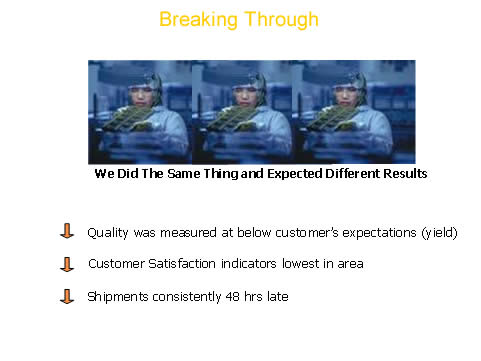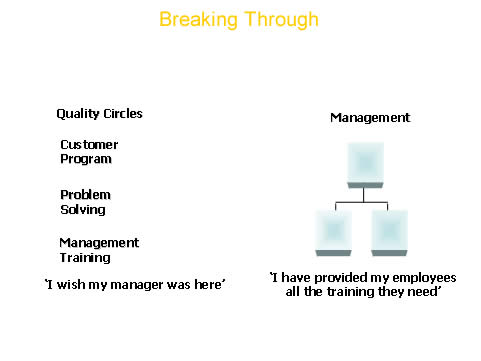 |
| Home | About Chin Teik Consulting Ltd. | Impact of Consulting | Products | Services | Association | Contact Us |
| |
| Damned If I Do Damned If I Don’t - Part II |
|
The Wall In part I, we explored what is the Growth Dilemma (aka The Wall), its definition, 3 examples and took you through the exercise of identification of The Wall. If you do not have a Growth Dilemma, you have the option of not reading this article. Breaking The Wall
When I was given the opportunity to implement the Total Quality Management (TQM) process ten years later, I took on a different approach in terms of organization effectiveness. In the past training was more like programs and delivered without any senior management engagement. Training was delivered directly to the middle or bottom of the organization typically missing the senior management team. A couple of years earlier I personally got my ‘a-Ha’ when I was involved in delivering a whole series of supervisory basic training to all the supervisors. During a module on Problem Solving, one of the supervisors told me that the structured problem solving steps are simple but very useful on the production floor. Then he paused and then said the following statement which I will always remember: ‘I wish my supervisor was here’. I also witnessed the organization’s inability to sustain the then famous Quality Circles Concept (QCC). There were a lot of cheer leading and celebrations with the QCC teams including the training and use of QCC tools during shift hours. The 30 QCC teams took time to make pretty foils and presented to senior management and senior management cheering them on after each presentation and saying that they will get back to the QCC teams on their suggestions. However, senior management did not get back to the teams with regards to the proposals. Reason was that the projects the QCC teams were working on were not in line with what the business needs were and thus did not have the budget to support the Circles’ improvement projects. This was due to the QCC team presentations’ timing was not in sync with the company’s budget and business planning cycle.
When management is separate from the ‘People Programs’ in the organization, there is a very high likelihood that the programs will not effect any change or impact on the organization’s bottom-line results. The term ‘program’ has an implication of ‘start’ and ‘end’ versus the term ‘process’ which has an implication of ‘on-going’.
Breaking Through – The Total Quality Management Story
How You Grow, Grows The Organization: Change Started At The Top: I spent a lot of time coaching the Managing Director. The Managing Director started to step out of his comfort zone and changed his behavior. First was learning about himself and his impact on his staff. Second was letting go and giving more decision making to his staff. We set up the Quality Improvement Process (QIP) Steering Council. The Managing Director role modeled the concepts of QIP; focusing on systemic issues and fixing them with structured problem solving vs. just blaming the people involved with the production. 3 Months Of Self Discovery By Senior Management Team: Every Friday lunch time, I facilitated the senior management team to discuss Dr. Deming’s and Dr. Juran’s concepts on Quality. They started by assessing themselves on the Quality Improvement Grid and at the end of every month re-assess themselves to look at improvements made. Shifted Behavior To Quality, Employee Engagement and Customer: The QIP Steering Council wrote the policy on ‘How To Set Up QIP Teams’. The start up of QIP team was different from the Quality Circles. Members of the QIP Steering Council were appointed as sponsors of the 5 QIP teams made up of the next level staff not the folks at the bottom of the org chart; the Sponsor and QIP Steering Council identified the problems that needed to be solved before identifying the QIP team members; QIP teams met every week applying the structured problem solving on the identified problems – and the structured problem solving was delivered by the sponsor in an action learning mode (i.e. each step was taught and then applied directly on a real problem without too much lecturing on concepts). We did not put the folks through a regular training class. With the help of the Managing Director and the QIP Steering Council, we also started to change the way business was run. The regular weekly Operations (Ops) meeting always begun with indicator review and we decided to start with quality indicator instead of shipment indicator. We also started to review Customer indicator in more detail. Over time, the QIP teams were slowly implemented downstream into the organization involving all levels of employees. The 5 original QIP team members became sponsors of the next level QIP teams and so forth. All the sponsors and leaders had hands-on experience and coaching from the senior management team. In the second year of QIP implementation, we also successfully implemented the suggestion program for all the operators on the manufacturing floor. 80/20; 20/80: One of the key things the Managing Director and the QIP steering council implemented was the organization’s strategic planning process. The strategic planning process goal was to ensure that the whole organization was working on the key important goals of the organization. The QIP teams’ objectives were aligned to those important goals and with that the resources and budget were in place. The teams were taught to work on 20% of the issues that had 80% impact on the results. The Management team also role modeled the 80/20 rule which is that 80% of all problems on the manufacturing floor came from systems and 20% came from the operators. Systems issues were the responsibility of management and so if there is anyone to blame, the blame should start with the top not the bottom. With this approach, the following ‘System of Management’ was embedded into the organization:
I would like to thank Brad Boyer of Boyer Communications and Bill Daniels from American Consulting & Training for helping me gain clarity around ‘The Growth Dilemma’. It was through hours of conversations with Brad and Bill separately that I became clearer with my company’s mission around Growth Dilemma. About The Author: Renowned worldwide for his dynamic and intuitive consulting process, Chin Teik’s specialization areas are executive coaching and/or executive team coaching on strategic planning system and process, organization effectiveness, leadership and management development and system of management implementation. Chin Teik also specializes in enabling ‘HR and Training strategies for organizational impact’ and implementing ‘Continuous Improvement Process’. Chin Teik’s coaching and consulting efforts cut across a wide range of industries from Legal, Water Utility, Elevator, Oil & Gas, Advertising, Packaging, Precision Engineering and Semiconductor A charismatic global leader, Chin Teik has amassed invaluable experience in manufacturing, training & development, total quality management and over 28 years of experience playing critical human resource roles in Intel on a regional and global scale. Chin Teik has to his credit the prestige of setting up the first-ever 10, 000 sq. ft. Intel University Training Center to deliver ‘Transformation of Workforce’ program to entire factory. Chin Teik also played an instrumental role in the founding of the Penang Skills Development Center. Chin Teik can be reached at chin.teik@chinteik.com. Copyright © 2007 Chin Teik Consulting Ltd
|
| Home | About Chin Teik Consulting Ltd. | Impact of Consulting | Products | Services | Association | Contact Us |


